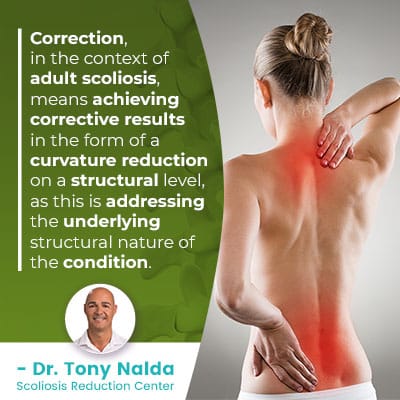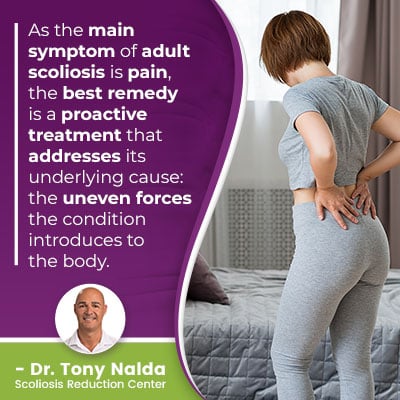Adult Scoliosis: Can You Correct Scoliosis In Adults?

Scoliosis is incurable, but it is highly treatable. Effective treatment for adult scoliosis includes condition-specific chiropractic care that works towards achieving a curvature reduction, increasing core strength, so the spine is optimally supported, and further stabilizing the spine.
Scoliosis is a structural spinal condition that’s progressive in nature, so while it can’t be cured in the traditional sense, it is highly treatable. Correcting scoliosis in adults means achieving corrective results that involve a curvature reduction on a structural level.
Before getting to the specifics of adult scoliosis, let’s first discuss the difference between curing and correcting scoliosis.
Table of Contents
Curing vs. Correcting Adult Scoliosis
While the question, can you correct scoliosis in adults, seems like it would warrant a simple yes or no answer, that’s not exactly the case.
Scoliosis is a highly-complex condition, not just because it ranges in severity from mild to moderate and severe to very severe, but also because it can affect all ages, develop anywhere along the spine, and there are different types with their own unique symptoms and treatment needs.
The very nature of scoliosis necessitates a customized treatment approach that is shaped around key patient/condition variables: patient age and overall health, curvature location, condition type, and severity.
 I also want to be clear that there is a significant difference between curing and correcting adult scoliosis.
I also want to be clear that there is a significant difference between curing and correcting adult scoliosis.
Curing, in the traditional sense, means a condition is treated, its underlying cause is addressed, and the condition will not return; scoliosis, however, is progressive.
The progressive nature of scoliosis means it will worsen over time, particularly if left untreated or not treated proactively.
So as scoliosis is progressive, treatment efforts focus on achieving corrective results while working towards counteracting the condition’s progressive nature.
Correction, in the context of adult scoliosis, means achieving corrective results in the form of a curvature reduction on a structural level, as this is addressing the underlying structural nature of the condition.
So now that we know the difference between curing and correcting adult scoliosis, let’s address some of the differences between adolescent and adult scoliosis.
Adult vs. Adolescent Scoliosis
Scoliosis doesn’t just range widely in severity, but there are also multiple condition types, and adolescent idiopathic scoliosis (AIS), diagnosed between the ages of 10 and 18, is its most-prevalent form.
Because scoliosis is so prevalent in children and adolescents, it’s often thought of as a child condition, but that’s not the case as it can affect all ages, from infants to the elderly and every age in between.
In adults, the two most common types of scoliosis are idiopathic and degenerative; cases of idiopathic scoliosis in adults are extensions of AIS that went undiagnosed and untreated throughout adolescence.
Degenerative scoliosis tends to develop after the age of 40 and is caused by natural age-related spinal degeneration, and in most cases, it’s the spine’s intervertebral discs that are the first spinal structures to feel the effects of deterioration.
The intervertebral discs sit between adjacent vertebrae (bones of the spine) to provide cushioning, so they are not generating friction during movement. In addition, the discs also help facilitate flexible movement, provide the spine with structure (vertebral bodies attached to the discs in between), and act as the spine’s shock absorbers.
If one or more discs start to degenerate, they can become desiccated and change shape, which affects the positioning of adjacent vertebrae and impairs the spine’s ability to function optimally.
Women are also more likely than men to develop degenerative scoliosis due to hormone and bone-density changes related to menopause.
Let’s now discuss one of the main differences between how adolescents and adults experience life with scoliosis: pain.
Pain
While it might seem difficult to imagine that an unnatural sideways spine curve, with rotation, could go unnoticed for so many years and progress through adolescence unnoticed, this is quite common.
In children and adolescents, scoliosis isn’t known to be painful, and this is due to growth and development.
Prior to reaching skeletal maturity, the spine is growing and experiencing a constant lengthening motion, and this counteracts the compressive force of the unnatural spinal curve.
It’s compression of the spine and its surrounding muscles and nerves that is the main cause of condition-related pain.
In AIS, particularly when mild, the condition isn’t associated with functional deficits, and the most common symptom of scoliosis in adolescents is postural deviation, but just as the condition ranges from mild to very severe, so too do its symptoms, and postural changes can be subtle and difficult for an average person to notice.
While no one wants to experience pain, it does serve a vital purpose: it tells us something is wrong inside the body.
Once skeletal maturity has been reached, the condition becomes compressive, which is why it’s not uncommon that it remains undetected until adulthood when it starts to produce noticeable symptoms like back, or radicular pain felt throughout the body.
So while the main scoliosis symptom in adolescents is postural deviation, it’s pain in adults, and another important difference is progression.
Progression
So we know that scoliosis is progressive, meaning it has it in its nature to worsen over time, but how quickly does this happen, and is the rate the same for everyone?
As mentioned, the most prevalent condition type in both adolescents and adults is idiopathic scoliosis, and while we don’t understand its etiology, we do know what triggers its progression: growth and development.
So, for adolescents, who are in or entering the stage of puberty characterized by rapid and unpredictable growth spurts, this age group is at risk for rapid-phase progression.
For adults who are no longer growing, that trigger is removed; however, adults will still progress over time, and while the rates tend to slow in adulthood, the cumulative effect of even incremental progression over time can still add up to a large scoliotic curve.
Also, in cases of degenerative scoliosis where spinal deterioration is occurring, this can increase the rate of scoliosis progression simply because the spine is experiencing degenerative changes: impacting the spine’s ability to maintain its natural curves and alignment.
Adult Scoliosis Treatment Options
So, while monitoring for progression and working towards counteracting it with a large curvature reduction is the focus of treatment in adolescents, in adults, the focus shifts to reducing the curve back to where it was prior to becoming painful, stabilizing the spine, and pain management.
 As the main symptom of adult scoliosis is pain, the best remedy is a proactive treatment that addresses its underlying cause: the uneven forces the condition introduces to the body.
As the main symptom of adult scoliosis is pain, the best remedy is a proactive treatment that addresses its underlying cause: the uneven forces the condition introduces to the body.
Here at the Scoliosis Reduction Center, I believe in the merits of proactive treatment started as close to the time of diagnosis as possible, and this is because, while there are no treatment guarantees when treatment is started early in a condition’s progressive line, there are fewer limits to what we can achieve.
Scoliosis is simplest to treat while the curve is at its smallest, most flexible, and before the body has had ample time to adjust to the unnatural spinal curve’s presence.
As scoliosis progresses, the spine becomes more and more rigid, making it stiff and painful, less flexible, and less responsive to treatment.
So oftentimes, particularly in my adult patients who have already experienced significant progression over time, I have to do some preparatory work to restore a baseline level of spinal flexibility before moving on to a curvature reduction and further stabilizing the spine.
In most cases, the components of my adult treatment plans would include in-office therapy, custom-prescribed home exercises, corrective bracing for support, pain relief, and augmenting corrective results, and gentle scoliosis-specific chiropractic adjustments for imparting the condition on a structural level.
Conclusion
So, can you correct scoliosis in adults? Yes, corrective results are within reach.
When proactive treatment that involves customizing plans to address key patient/condition variables is applied, adults can achieve enough of a curvature reduction to minimize the condition’s symptoms and effects.
In addition, through a variety of therapies and scoliosis-specific exercises, core strength can be increased so the muscles that surround the spine can optimally support it, and through custom-prescribed home exercises, a home-rehabilitation program can be established for further stabilizing the spine and long-term sustainable results.
Corrective bracing can also help augment corrective results in my adult patients while providing extra support for the spine and pain relief.
Here at the Center, I always tell patients that regardless of age or condition severity, the best time to start treatment is always now, particularly when it comes to a progressive condition like scoliosis.
Proactive treatment is the only way to counteract the condition’s progressive nature, impact the condition on a structural level, increase core strength, stabilize the spine, and avoid increasing condition severity and the need for invasive treatment in the future.
Dr. Tony Nalda
DOCTOR OF CHIROPRACTIC
After receiving an undergraduate degree in psychology and his Doctorate of Chiropractic from Life University, Dr. Nalda settled in Celebration, Florida and proceeded to build one of Central Florida’s most successful chiropractic clinics.
His experience with patients suffering from scoliosis, and the confusion and frustration they faced, led him to seek a specialty in scoliosis care. In 2006 he completed his Intensive Care Certification from CLEAR Institute, a leading scoliosis educational and certification center.
About Dr. Tony Nalda
 Ready to explore scoliosis treatment? Contact Us Now
Ready to explore scoliosis treatment? Contact Us Now





